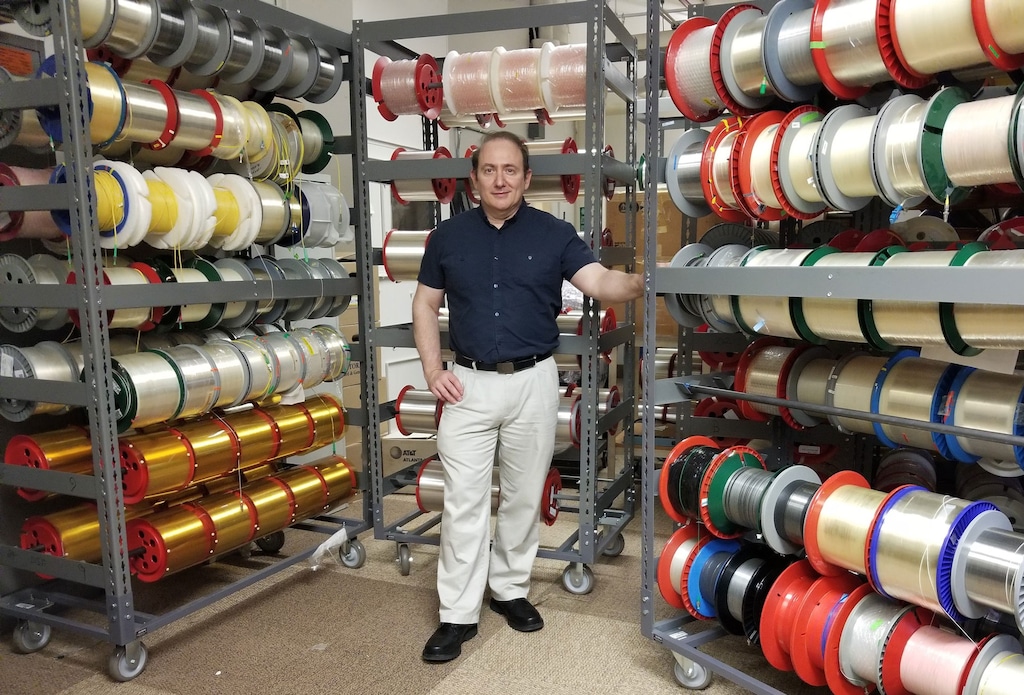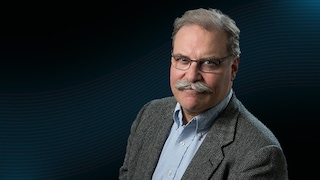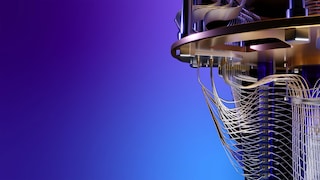Quantum physics is reshaping the fundamentals of networking
By Theodore Sizer
29 July 2025

Theodore Sizer, Head of Optical Systems and Device Research at Nokia Bell Labs, is a leading expert on quantum networking. In this viewpoint piece, he shares his perspective on how quantum technologies could usher in an era of extremely low-power and hyper-secure networks.
There is a quiet revolution happening at Nokia Bell Labs’ networking research groups. As we enter the Quantum 2,0 era, we are learning to manipulate photons of light in new ways. This is, in turn, leading to new possibilities for optical networks and communications.
We are using quantum entanglement and quantum superposition to make optical networks entirely opaque to outside observers and encode data into the most rudimentary particles in nature. Over the next decade, we will see these tools transform networking in three distinct ways: the amount of energy communication networks consume when faced with ever-increasing demand, the enhanced privacy of our communications and the creation of new kinds of networks to support the broader quantum-technology ecosystem.
Harnessing the full power of the photon
Our constant hunger for more data capacity is creating an existential problem for the communications industry. The amount of data the world consumes has been increasing by a factor of 10 every decade, and that trend shows no sign of abating. But whenever capacity increases, the power required by our networks increases as well.
This is simply unsustainable. On our current trajectory, data demand in 2045 will be 100 times greater than it is today. But to meet that demand with today’s technologies we would also need to increase the electricity networks consume 100-fold. Planet Earth simply doesn’t have the natural resources to support that kind of growth using current networking capabilities.
But quantum technologies may hold the key. Using quantum mechanics, we can pack far more information into a single photon of light. A photon containing one bit of information and a photon containing 10 bits of information use the same amount of energy when transmitted. This could have major implications for the way we communicate in the future as well as communications’ impact on the planet and on society.
Nokia Bell Labs’ René-Jean Essiambre is doing foundational research into the potential applications for this technology. By encoding more information into a single photon, we can substantially reduce the amount of energy needed to transmit large volumes of data. We are not talking about a 10% or 20% reduction in optical power. Rather, we are talking anywhere from a factor of two to an order of magnitude. Once we’ve fully harnessed the potential of quantum science, many optical communications networks could be designed to operate using a fraction of energy of today’s networks, while simultaneously meeting the massive demand for more capacity we expect to see over the next two decades.

Energy optimization, however, is just one facet of this groundbreaking research. For example, by manipulating photons in special ways, we can send large volumes of information over extremely long distances. This technology could be key in bringing future colonies on the Moon and Mars into an interplanetary internet.
Hyper-secure networks will underpin the quantum era
As with any innovation, quantum technologies can be misused. When quantum computers become powerful enough, they will be able to crack the encryption that protects much of today’s data and communications. It may well be another decade before this kind of cryptographically relevant quantum computer (CRQC) is born, but security risks are very real today. There are those who are harvesting our most sensitive encrypted data from networks right now, waiting for a day a CRQC comes online to decrypt it.
Even as the threat to security grows, so does our dependence on the network. More of our lives are moving online — our finances, our work, our healthcare, our education and our social interactions are increasingly conducted in the digital world rather than the physical world. Ensuring that our communications are secure and our personal data remains private is becoming the foremost priority in networking.
Luckily quantum technologies provide tools that will make these hyper-secure networks possible. We can break quantum security down into two categories: data security and connection security.
Data security is when we send communications from point A to point B in a public, yet secure, way. A hacker knows information is being sent, but due to encryption, this hacker has no way of understanding what is being said. This is how we protect the vast majority of data that currently traverses the internet.
Today, this encrypted data is uncrackable for all practical purposes, but when a CRQC emerges, not only will our future data be exposed but also any sensitive data that is being harvested and stored today.
One defense against these data security threats is post-quantum cryptography (PQC) — essentially encryption that generates algorithmic puzzles even a quantum computer can’t solve. The first round of PQC algorithms have been standardized and are making their way into our networks. Nokia plans to implement PQC into its network solutions as soon as the algorithms are available, adding it to the multiple layers of quantum-safe technology we already offer.
Connection security is when we not only protect the data sent over a communications channel, but also the connection itself. A hacker has no means of intercepting the information, nor do they have any knowledge of who is receiving it or that communication is even occurring.
One way we can achieve connection security is through a technology called quantum key distribution (QKD), which allows us to send information — in this case the encryption keys — in a quantum state. When an eavesdropper disturbs the photons in this QKD link, their quantum-entangled state is lost, allowing us to detect any attempt at interception. In short, QKD has the potential to lock our data behind the immutable laws of physics.
Today QKD is deployed commercially on single fiber links or on links that use trusted satellite nodes. For instance, Nokia is collaborating with Honeywell and Colt Technology Services on space-based QKD.

Theodore Sizer
Meanwhile, at Nokia Bell Labs, Amirhossein Ghazisaeidi is exploring future directions for QKD. His work on continuous-variable QKD has the potential to turbocharge the technology by generating secret encryption keys at a faster pace, thus providing even higher levels of connection security.
A network of interconnected quantum computers
As quantum computers and other quantum devices proliferate, we will need specialized quantum networks to interlink them. This system of networks is often referred to as the quantum internet, but “internet” isn’t the best analogy. Quantum networks won’t replace the internet we know today. Rather, they will augment the classical internet, working in parallel to provide additional security and new communications capabilities. The major distinction between these quantum networks and the classical internet will be that information carried over them will be sent in a quantum state.
One of the major uses for quantum networks will be interconnecting quantum computers to scale their potential. Today’s network infrastructure is badly suited to distributed quantum computing as it requires converting information from a quantum state into a classical state (zeros and ones) before it travels between quantum computers. Distributed quantum computing provides the greatest benefit if the information shared between these computers is maintained in a quantum state. This means generating quantum communications links between each quantum computer.
We expect that quantum networks will be used to scale quantum computing within data centers. It remains to be seen whether distributed quantum computing will also find an application in the wide-area network of the foreseeable future. But we will have an immediate need for a wide-area quantum network to create the quantum links necessary to practically implement QKD on a global basis.
Creating these quantum links is easier said than done. Quantum states are very fragile and can be disturbed by the slightest fluctuations in noise, vibration, temperature and even gravity. To build large-scale quantum networks we will need new devices, components and infrastructure. Much of this is in the theoretical stages today, but Nokia Bell Labs is doing the fundamental research into making this technology reality.
One prime example is the work we are doing into devising a quantum repeater, which could overcome the single biggest impediment to quantum networks. Today, we can only maintain a quantum communications channel over a single fiber-optic link for about 100 km. Unless we want to severely limit the scope of the quantum communications, we need to find ways of moving from individual connections to networks of fiber connections. With quantum repeaters, we could reinforce and relay the quantum state of information as it traverses fiber infrastructure, creating wide-area quantum networks on a global scale.
Quantum won’t just impact networking communication. With quantum computing we will be able to out-calculate today’s most powerful supercomputers, and with quantum sensing we will be able to expand our understanding of the natural world. The role quantum networking will play in this new Quantum 2.0 world cannot be underestimated.
Computing and networking have always been irrevocably linked, and that bond will only grow stronger. In the long-term future, photonic quantum technology won’t merely play an important role in linking quantum computers; it could assume some of quantum computers’ processing capabilities as well. This could signal a new era where the line between computation and communication begins to fade.
Discover more

Topic
Quantum technologies

Blog
Connecting the far reaches of the solar system with low-power quantum detection

Article
5 misconceptions about Q-Day
About Nokia
At Nokia, we create technology that helps the world act together.
As a B2B technology innovation leader, we are pioneering networks that sense, think, and act by leveraging our work across mobile, fixed and cloud networks. In addition, we create value with intellectual property and long-term research, led by the award-winning Nokia Bell Labs.
Service providers, enterprises and partners worldwide trust Nokia to deliver secure, reliable and sustainable networks today – and work with us to create the digital services and applications of the future.
Media inquiries
Nokia Communications, Corporate
Email: Press.Services@nokia.com
Follow us on social media
LinkedIn Twitter Instagram Facebook YouTube

